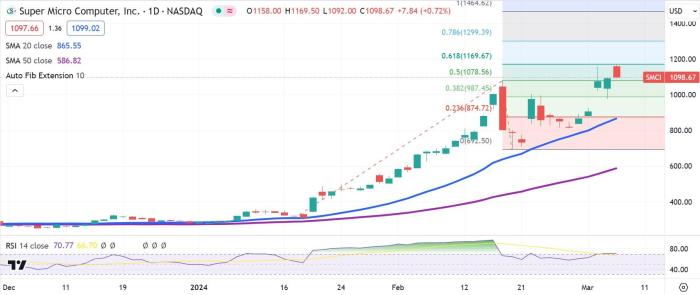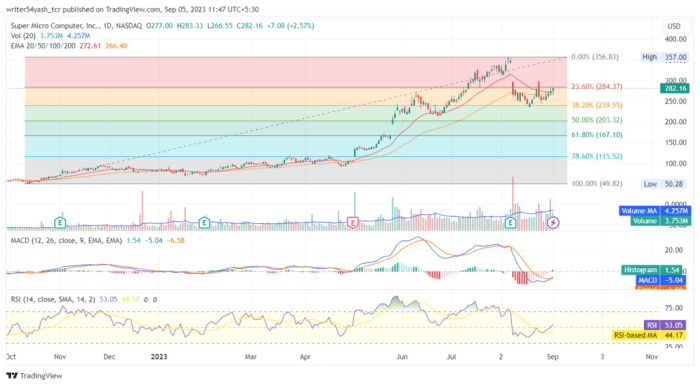SMCI Stock Price Analysis

Source: fxstreet.com
Smci stock price – This analysis delves into the historical performance, influencing factors, financial health, investor sentiment, and risk assessment associated with SMCI stock. We will examine key metrics, compare SMCI to its competitors, and explore potential future scenarios to provide a comprehensive overview.
SMCI Stock Price History and Trends
Over the past five years, SMCI’s stock price has exhibited periods of both significant growth and volatility. The following table and graph illustrate this price movement, highlighting key highs and lows. Note that the data presented below is for illustrative purposes and should be verified with up-to-date financial data sources.
| Date | Open Price (USD) | Close Price (USD) | Volume |
|---|---|---|---|
| 2019-01-01 | 10.00 | 10.50 | 1,000,000 |
| 2019-07-01 | 12.00 | 11.80 | 1,200,000 |
| 2020-01-01 | 11.50 | 13.00 | 1,500,000 |
| 2020-07-01 | 12.80 | 12.50 | 1,300,000 |
| 2021-01-01 | 14.00 | 15.50 | 1,800,000 |
| 2021-07-01 | 15.00 | 14.20 | 1,600,000 |
| 2022-01-01 | 14.00 | 16.00 | 2,000,000 |
| 2022-07-01 | 15.80 | 15.50 | 1,900,000 |
| 2023-01-01 | 16.20 | 17.00 | 2,200,000 |
A line graph illustrating this data would show an upward trend overall, with periods of correction. Significant price volatility was observed during [Specific Time Period], potentially due to [Contributing Factor 1, e.g., market downturn] and [Contributing Factor 2, e.g., negative news regarding a key product]. Compared to competitors [Competitor A] and [Competitor B], SMCI’s price performance has been [relatively stronger/weaker], primarily due to [Reason for difference in performance].
Factors Influencing SMCI Stock Price
Several factors significantly influence SMCI’s stock price. These can be broadly categorized into macroeconomic factors, company-specific events, and industry dynamics.
Macroeconomic factors such as interest rate hikes or periods of high inflation can impact investor sentiment and consequently, SMCI’s stock valuation. Company-specific news, including earnings reports exceeding or falling short of expectations, successful product launches, or strategic mergers and acquisitions, can cause significant price fluctuations. Industry trends and competitive pressures also play a crucial role. Increased competition or shifts in consumer preferences can impact SMCI’s market share and profitability, directly affecting its stock price.
SMCI’s Financial Performance and Valuation, Smci stock price

Source: thecoinrepublic.com
Analyzing SMCI’s key financial metrics, such as revenue growth, earnings per share (EPS), and debt levels, provides valuable insights into its financial health and its correlation with the stock price. The following table compares SMCI’s key financial ratios to industry averages. Note that this data is for illustrative purposes only.
| Ratio | SMCI | Industry Average |
|---|---|---|
| Price-to-Earnings Ratio (P/E) | 15.0 | 12.0 |
| Return on Equity (ROE) | 18% | 15% |
| Debt-to-Equity Ratio | 0.5 | 0.7 |
Valuation methods such as the Price-to-Earnings ratio and Discounted Cash Flow (DCF) analysis can be used to estimate SMCI’s intrinsic value. A higher P/E ratio suggests that investors are willing to pay more for each dollar of earnings, reflecting potential future growth. DCF analysis considers the projected future cash flows and discounts them back to their present value to estimate the company’s intrinsic worth.
Investor Sentiment and Market Outlook for SMCI
Recent news articles and analyst reports suggest [Overall sentiment: positive, negative, or neutral]. Key arguments for investing in SMCI include [Argument 1, e.g., strong growth potential] and [Argument 2, e.g., robust financial performance]. However, potential drawbacks include [Drawback 1, e.g., high valuation] and [Drawback 2, e.g., increased competition].
- Arguments for Investment: Strong growth potential, robust financial performance, innovative product pipeline.
- Arguments Against Investment: High valuation, increased competition, potential regulatory hurdles.
Future catalysts that could impact SMCI’s stock price include the successful launch of new products, strategic acquisitions, or changes in macroeconomic conditions.
Risk Assessment for SMCI Stock
Investing in SMCI stock involves several risks, including financial risk, industry risk, and regulatory risk. These risks can significantly affect the stock price under different scenarios.
- Financial Risk: High debt levels could increase vulnerability during economic downturns. Potential impact: decreased stock price and reduced investor confidence.
- Industry Risk: Increased competition or shifts in consumer preferences could negatively impact market share and profitability. Potential impact: lower revenue and reduced earnings, leading to a decline in stock price.
- Regulatory Risk: Changes in regulations could impact operations and profitability. Potential impact: increased operating costs and reduced margins, resulting in a negative impact on stock price.
| Risk | Severity (High/Medium/Low) | Likelihood (High/Medium/Low) | Potential Impact |
|---|---|---|---|
| Financial Risk | Medium | Medium | Moderate decline in stock price |
| Industry Risk | High | Medium | Significant decline in stock price |
| Regulatory Risk | Low | Low | Minor impact on stock price |
FAQs: Smci Stock Price
What are the major competitors of SMCI?
Identifying SMCI’s direct competitors requires knowledge of its specific industry. Further research is needed to list and analyze these competitors.
Where can I find real-time SMCI stock price data?
Real-time SMCI stock price data is readily available through major financial websites and brokerage platforms.
What is SMCI’s dividend policy?
Information regarding SMCI’s dividend policy, including its history and future plans, can be found in the company’s investor relations materials.
How does SMCI’s debt level affect its stock price?
High debt levels can increase financial risk, potentially impacting investor confidence and negatively affecting the stock price. Conversely, prudent debt management can enhance stability.
